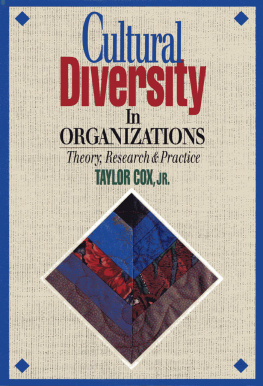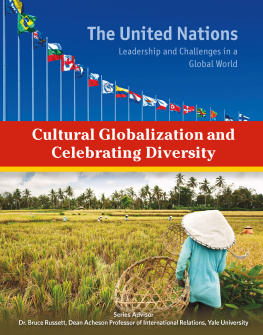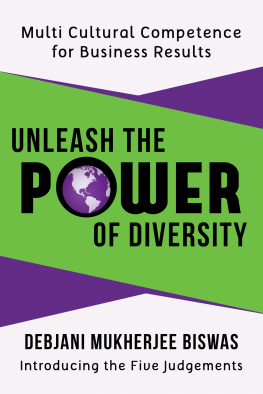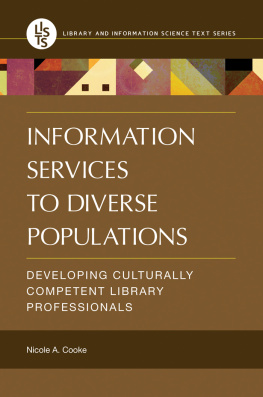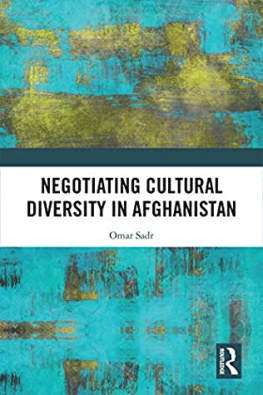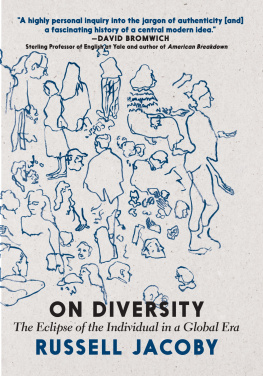Praise For
Cultural Diversity in Organizations
Taylor Cox has done an admirable job in analyzing the what, why, and how of valuing diversity. A must read for all who hope to benefit from the realities of a changing workforce.
Rosalie L. Tung,
The Ming & Stella Wong Professor of International Business,
Simon Fraser University
I have conscientiously attempted to read every book written on organizational diversity since I began to write about these issues some twenty years ago. In this context, I can honestly say that without a doubt, Cultural Diversity in Organizations is the most well thought out; the most well integrated; the most comprehensive; and the most significant academic undertaking that I am aware of on the complex and emotionally laden but critical issue of diversity.... Taylor Cox has made a major contribution to the field of organizational studies by providing a holistic and inclusive conceptual framework that is far in advance of any existing theory. Nowhere else am I aware of the existence of such an integrated compendium of critically important, research-based data, compiled in a manner that provides the platform for defining the issues, the stakes, and the challenges.
Edward W. Jones, Jr.,
president, Corporate Organizational Dynamics Inc.
This is a unique yet long overdue book. I do not believe that any author has attempted to capture the enormous complexity of cultural diversity in organizations as has Taylor Cox. And he has done it well! In a readable but still systematic and objective analysis, the author helps the reader to understand diversity issues in organizations and provides ways of making it happen in an effective manner.
Managing Diversity newsletter
Taylor Cox offers a systematic and objective analysis that can help anyone become more proficient at developing diversity. I am impressed that Cultural Diversity in Organizations is so readable and yet so thoroughno small achievement!
Ann M. Morrison,
author, The New Leaders, and coauthor,
Breaking the Glass Ceiling
Taylor Cox charts new territory in Cultural Diversity in Organizations, effectively weaving theory and research into a persuasive model for change. Concrete examples brilliantly illustrate the bottom-line impact of investing in diversity. Anyone interested in understanding the connection between multicultural diversity and organizational success will benefit from this book.
Kim Cromwell,
diversity programs manager,
Digital Equipment Corporation
The interweaving of the scholarly, the pragmatic, and the compassionate creates a powerful statement.
Gillian Stamp,
director,
Brunei Institute of Organization and Social Studies,
Brunei University
Taylor Cox provides a highly useful model for understanding the impact of diversity on individual and organizational outcomes and has supported it with a strong base of knowledge and expertise. He uses this model as the foundation for convincingly describing the dynamics of diverse work settings. Perhaps the most important contribution of this book is the discussion on organizational change and development, which describes a useful set of concepts and tools for creating multicultural organizations.
Jerry I. Porras,
Fred H. Merrill Professor of
Organizational Behavior and Change
and Associate Dean for Academic Affairs,
Graduate School of Business, Stanford University
Cultural Diversity in Organizations is an impressive contribution to advancing our thinking and understanding about the complex field of diversity. It combines a credible conceptual framework with practical suggestions to improve business results by increasing the productivity and development of each and every employee.
Tom White,
manager of human resources,
Exxon Research and Engineering Company
TAYLOR COX, JR .

To my wife, Cynthia, with much love

Contents
Celia V. Harquail and Taylor Cox, Jr.

In this book I have assembled learnings from ten years of teaching, research, and consulting related to the topic of cultural diversity in organizations.
My objective in creating the book was to provide a comprehensive text that would be useful as an aid for teaching, organization development, and scholarship. My primary targets are teachers and students of diversity, whether they are on university campuses or in the classrooms of business and community organizations. I also hope that Cultural Diversity in Organizations will be found useful by organizational scholars seeking to build a foundation foror to extendtheir own ideas and research directions on topics related to diversity in organizations.
Useful Features of This Book
There are several features of the book that I believe will make it especially useful to readers. One is that the book is developed around a specific conceptual model that frames the issues in a systematic way. The model represents my attempt to communicate dimensions and dynamics of diversity, which are generic issues across many types of group identities. Hence I do not have separate chapters on gender, race, age, and so on. Instead, I have attempted to integrate examples using the group identities throughout the book as various aspects of the model are discussed.
A second feature is that the book addresses the topic on three levels of analysis: the individual, the group, and the organization. I believe this multidimensional approach comes closer to capturing the enormous complexity of the topic than would be true if only one perspective were emphasized. This complexity exacts a price: it was not feasible to present a thorough discussion of all the relevant literature on each aspect of the model. Thus the book is intended to give examples of pertinent theory and research on the points raised rather than provide definitive coverage of individual topics.
Third, the book provides what I hope is a substantive and fairly comprehensive treatment of the topic, applying knowledge collected from several fields of inquiry to the organizational context. A considerable amount of relevant theory and empirical research is reviewed, which I believe makes clear that there is a base of knowledge that we can use to inform teaching, organizational interventions, and future research related to diversity in the workforce. The liberal use of references in the book is intended to aid further study of specific issues.
Overview of the Contents
Part One opens with a chapter that explains what I mean by cultural diversity and presents my conceptual model of diversity (the Interactional Model of Cultural Diversity), on which much of the book is based. Chapters Two and Three make the case for why managing diversity is among the most important management challenges of this decade. These chapters should increase the readers motivation to study the material presented in Parts Two through Four.

